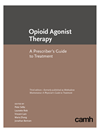Text adapted in 2023 from "Opioid Use and Opioid Use Disorders" in The Primary Care Addiction Toolkit. Available online only.
The Opioid Risk Tool (ORT) and the ORT-OUD are two brief screening tools that primary care providers can use to identify patients at high risk for opioid addiction (Cheattle et al., 2019). The ORT self-report screener determines the risk of problematic opioid use in patients who are prescribed opioids to manage chronic pain. Those at high risk are more likely to engage in opioid-related aberrant behaviours, such as obtaining opioids from multiple providers or escalating their dose without the prescriber’s authorization. The ORT is most useful when it is completed before the patient begins treatment with opioids.
The ORT-OUD predicts a patient’s risk of developing an opioid use disorder while they are on opioid therapy. Key factors related to risk are personal or family history of substance use problems, particularly with prescription medication, and concurrent psychiatric disorders. Screening for other substance use, as well as comorbid mental health conditions, should be a routine part of screening for opioid use disorder.


